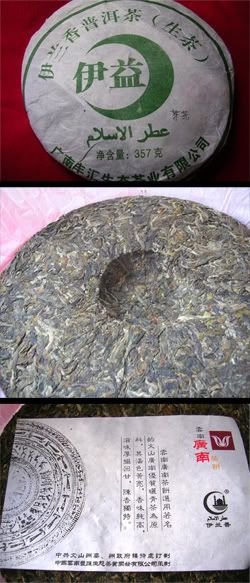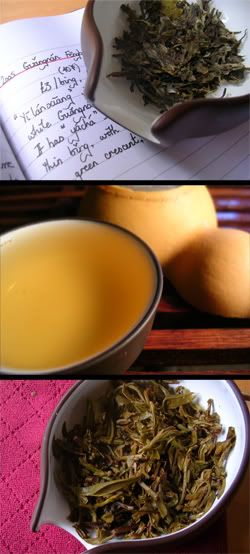 Indicative of his non-existent market for pu'er, the merchant only kept 30 cakes in total, of which Xiaomao took most after a few tasting sessions. They were priced just above the factory price: he paid 25 yuan (~$3) per cake from the factory in 2005, and with transportation, isn't making much profit on the 40 yuan (~$5) at which he sold to Xiaomao.
Indicative of his non-existent market for pu'er, the merchant only kept 30 cakes in total, of which Xiaomao took most after a few tasting sessions. They were priced just above the factory price: he paid 25 yuan (~$3) per cake from the factory in 2005, and with transportation, isn't making much profit on the 40 yuan (~$5) at which he sold to Xiaomao.Guangnan is the county name in Yunnan, while Fenghui is the factory. The bing, as you can see, is very Muslim in appearance: green crescents, Arabic script, an icon of a mosque - perhaps all indicative of the Muslim Hui minority. The characters in the crescent are "Yiyi", while the brand is "Yilanxiang", over the top. In small hand-written script on the right of the crescent is "yacha" [tip-tea], presumably placed by the merchant.
The cake has a fresh, almost minty feeling reminiscent of some Xiaguan tuocha. It's a thin, thin cake (while still being the usual 357g weight), and yet the compression is not too tight. Insertion of the pu'erdao around the edge in several spots, with some lateral lifting, and it comes apart quite easily - and is easily separable into individual leaves thereafter.
Caledonian Springs @ 100C in 12cl young shengpu pot; ~7g leaf; 1 rinse
Dry leaf:
Very tippy, all the way through the bing, living up to "yacha". Some darkness, but generally quite light. A sweet aroma, good and clean, with no smokiness.
3s, 5s, 5s, 5s, 7s, 10s, 10s, 15s:
 The wenxiangbei is interesting: it opens with a fruity, almost maofeng aroma, then becoming super-sweet, like candy. The lengxiang is enduring, which is a good sign.
The wenxiangbei is interesting: it opens with a fruity, almost maofeng aroma, then becoming super-sweet, like candy. The lengxiang is enduring, which is a good sign.The freshness of the aroma continues into the flavour, which covers the lips in a clean oil. It has a good strength, which would overpower if the infusions were longer than 3-5s. Evidence of a decent breadth of flavour is apparent, swelling and becoming more prominent like a wave as we approach the fourth infusion. The colour similarly deepens into a solid yellow-orange in conjunction with the flavour.
The chaqi causes flushing in my throat and prickles on the back of my scalp. The flavour settles into a more normal straw-like character near the sixth infusion. A mouth-watering but uncomplex huigan shows fair patience.
Wet leaves:
Yecha indeed, and it's interesting that the flavour can come from something so green.
Overall:
Judged on its own merits, independent of price, it's a decent tea, with the good strength and fair depth of flavour that make it appealing for aging. Combined with the price, however, and the scales tilt further in favour of it - it's a decent tea at a very old-fashioned price. It'll be interesting to see what happens to this tea over time - most of it is back at the family home in China, but we have some back in England for comparison.
It's definitely going to be worth hitting some more of the tea merchants around the Xinyang area when we're next back, if this trend continues outside Xiaomao's home-town. I find myself wondering if rural, lucha- or hongcha-drinking locations across the country have similar untapped reserves of decent, inexpensive tea. It might be worth spending a week or two to find out.

I can report that my hometown of Changshu, being in a relatively prosperous area of the country, has no such thing -- puerh doesn't even make it into many stores, and the ones that do are selling them at high prices. I suspect we're too close to a big city.
ReplyDeleteOn to your cake -- it's specially made by some government entity's reception house, quite interesting. No sign of it on Taobao at all after a search. Any bitterness? You didn't say anything about that.
Either way -- it's fun when you have mystery cakes like this!
Ah yes, I gathered from your blog that it was fairly close to Hangzhou and Suzhou. Just as you say, I suspect that makes pu'er a commodity there. Xiaomao's hometown is fairly remote.
ReplyDeleteThanks very much for the notes on the cake - Xiaomao was fascinated to learn of your comment on the reception-house. Did you glean this from the neipiao?
The cake has a ton of bitterness (the "strength" that I referred to), but it's kept under control by keeping the infusions down.
A bit of fun, yes indeed!
Toodlepip,
Hobbes
Interesting cake, very multi-cultural...? The liquor certainly looks quite tasty on your pictures.
ReplyDeleteAnd, is that a weird looking tea strainer in the background there!?
-vl.
It says in the bottom of the neipiao -- "Ordered by the Chinese Communist Party Wenshan County (party) committee, County Government Reception Bureau"
ReplyDeleteVL,
ReplyDeleteYou are indeed "made of eyes"*! Xiaomao brought back a small pile of cheap hulu [gourd-squash things made into filters].
*To quote Hot Fuzz one more time.
LZ,
Interesting - I wonder if the reception was anything to do with a Muslim group, given the interesting characters. I don't believe Wenshan is a big Hui-minority area.
Toodlepip,
Hobbes